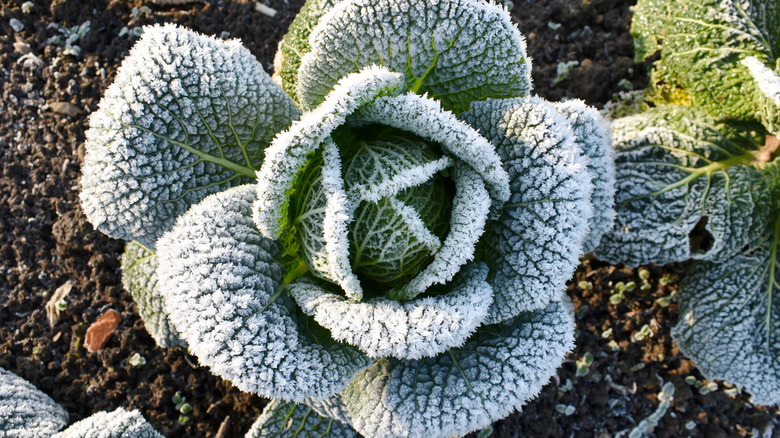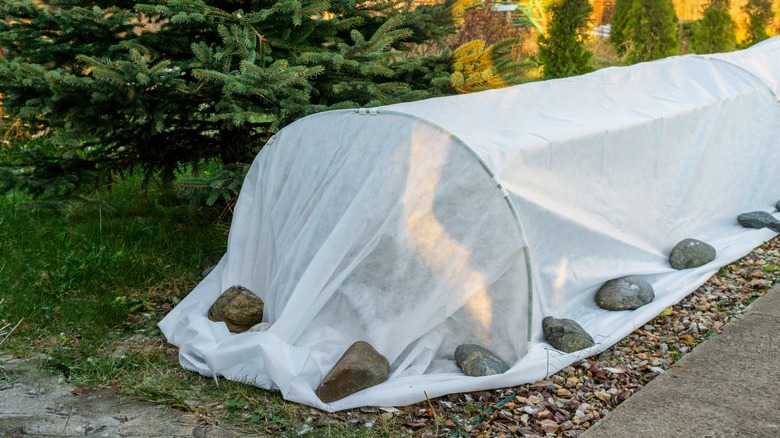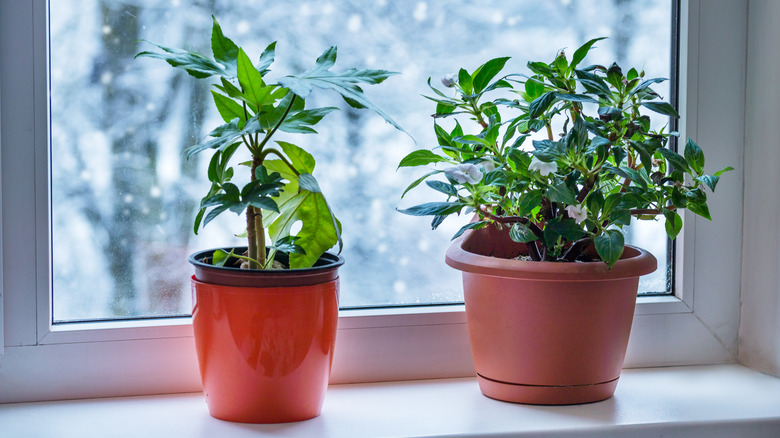The Best Material To Cover Your Plants With To Protect From Frost
During the fall and spring, one of the largest threats to growing crops is frost. According to Wenke Greenhouses, frost damage can happen when the moisture on your crops freezes during cold winter nights. As Green Impressions points out, this can cause significant damage to the plant, which may include softened leaves, brown spots, and dryness.
The first step to avoiding the deadly frost is knowing when temperatures are likely to drop and which plants cannot stay out in the cold. According to the trusty Old Farmer's Almanac, tender vegetables like sweet corn are threatened in temperatures below 32 degrees Fahrenheit, while hardier crops like spinach and kale will survive. Some plants like broccoli and root vegetables can actually improve in taste if exposed to freezing temperatures.
Once you've determined when the frost is likely to occur and which plants need to be covered, you'll then need to choose the right frost-fighting material. Below, you'll discover the best material to use, as well as some other ways to keep your plants warmer in cold weather.
Always choose fabric over plastic
Fabric and plastic materials are the most common choices for covering plants, and between these options, fabric is the clear winner, advises Green Impressions. This is because plastic can get stuck to your plants or trap in excessive moisture, both of which could cause even more damage than a frost would. In fact, because of this, Growing In the Garden goes so far as to recommend not using plastic at all.
On the other hand, fabric allows moisture to escape. Extra bed sheets, towels, or blankets could be used, however, these fabrics should never touch your crops, so make sure to also utilize stakes or wire hoops, per The Creative Vegetable Gardener. You could also purchase gardening blankets or row covers, which come in different weights. Heavier weights are to be used in the fall, while lighter weights are best in the spring to allow sunlight to filter through.
Make sure the task of covering your plants is completed before the sun sets so that the soil's heat gets trapped inside. Also, if you're using something other than a row cover, you'll need to remove it during the day to avoid accidentally forcing your crops to overheat.
Other ways to fight frost
There are additional ways to protect your plants from frost. If you're growing vegetables in containers you could bring them inside or place pots under a roof during cold nights, suggests Bio Advanced. Painting full water jugs black, keeping them in the sun, and then placing them next to your plants could help keep them warm during cold nights. Another thing to do is position incandescent light bulbs within 3 feet of your plants. When they're switched on, the bulbs release heat.
The Old Farmer's Almanac says you can create a makeshift hot cap (basically a small greenhouse) by cutting a soda bottle in half and placing it over an individual plant. Mulch can be applied to cover low greenery during the night, just remove it during the day. Growing In the Garden adds that where you plant your tender crops can make a massive difference. Delicate plants that need to stay warm should be planted in a high area of your yard near a block or brick wall. At nighttime the wall will emit the heat it absorbed during the day.


